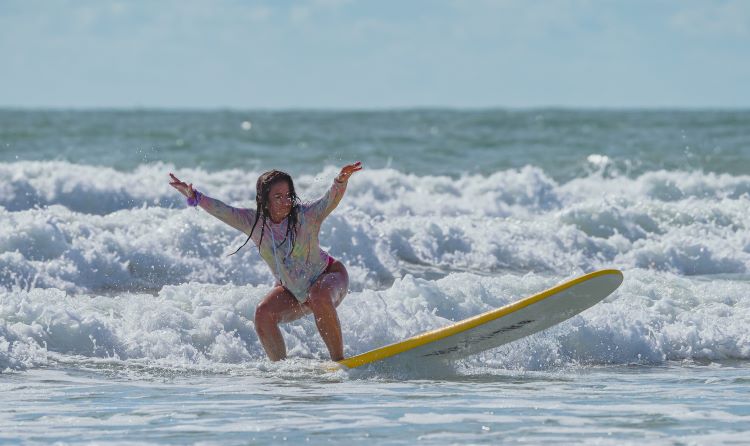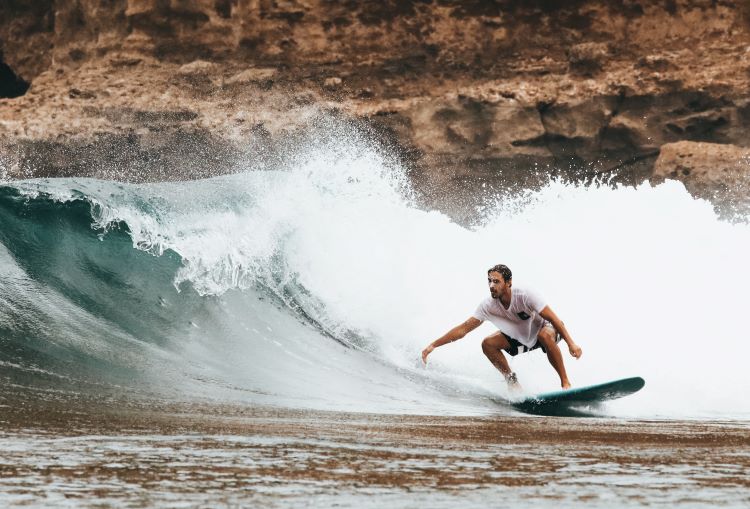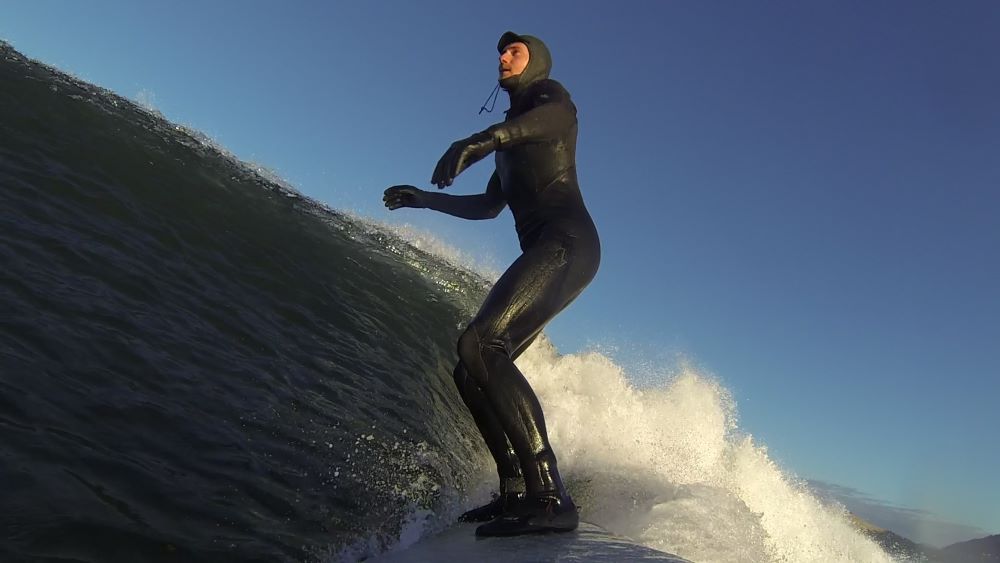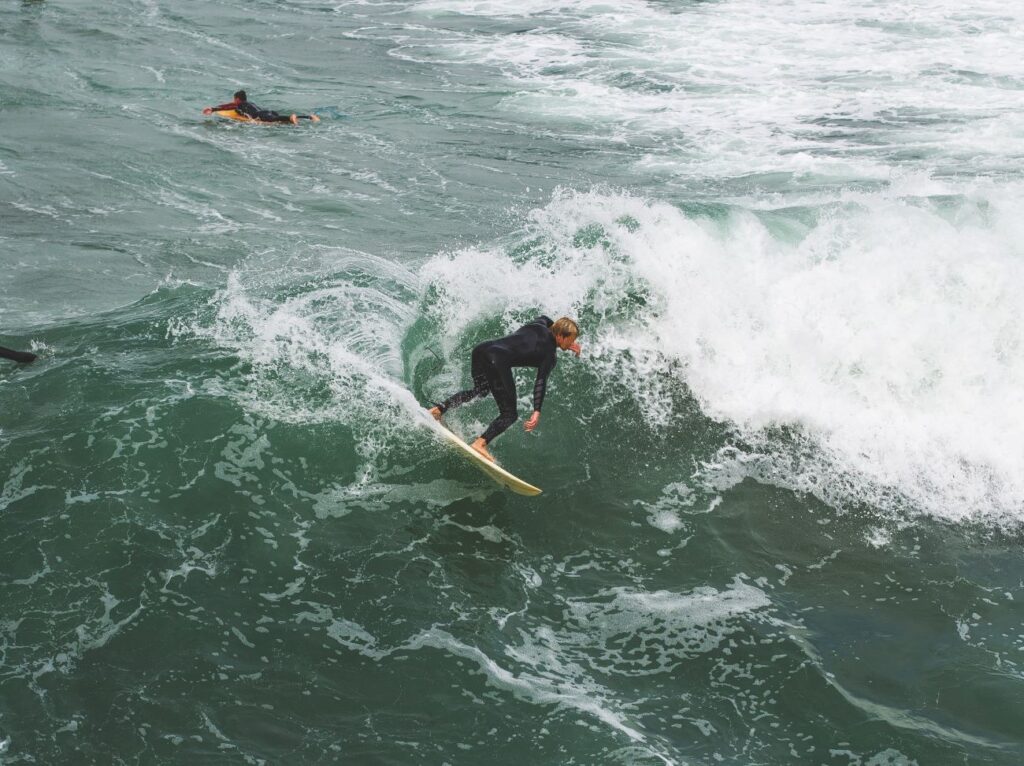If you are a beginner surfer or even if you have never surfed, you might be wondering: how long does it take to learn how to surf? Well, it depends on how often you surf, what the conditions are, and what type of board you are using.
In general, it takes people between 10 and 50 hours to learn how to surf. This equates to a time period of one to five months, assuming you surf 10 hours per month.
However, surfing is a complex sport, and a more detailed answer is needed to understand how long it takes to learn how to surf. In this article, we dive into the different stages of learning how to surf, what abilities they are defined by, and the amount of time needed to get there.
| Surfing Skill Level: | True Beginner | Beginner | Intermediate | Advanced |
| Number of hours needed | 1 – 10 hours | 10 – 50 hours | 50 – 500 hours | 500+ hours |
| Number of 4 hr sessions needed | 1 – 3 sessions | 3 – 13 sessions | 13 – 125 sessions | 125+ sessions |
| Time needed (surfing 10 hours per month) | < 1 month | 1 – 5 months | 5 – 50 months | 50+ months |
Stages of surfing: beginner to advanced
In reality, it is difficult to define surfing proficiency. Surfing is a complex sport with many different skill levels and styles. Generally speaking, surfing ability can be broken down into four levels. Each of these levels is associated with different skills.
| Surfing Skill Level: | True Beginner | Beginner | Intermediate | Advanced |
| Getting out to the break | Stay in whitewater: walk out and hold board until unable to stand | Paddle out to break. Basic duck dive / turtle rolls | Paddle out to break. Proficient in duck dive / turtle rolls. May utilize rip currents | Paddle out to break. Near perfect form in duck dive / turtle rolls. May utilize rip currents |
| Catching a wave | Catch a broken wave from standing. Pop-up is slow | Catch a slow-moving unbroken wave. Pop-up may be slow. Timing may be off | Catch an unbroken wave. Pop-ups are fast. Timing is good/great | Catch fast and steep waves. Pop-ups are fast. Timing is near perfect |
| Riding a wave | Stand up and ride straight toward the beach | Ride the face of the wave straight toward the beach or at an angle | Ride the face of the wave at an angle. Perform basic turns. Can ride both lefts and rights | Perform advanced turns and other maneuvers |
| Typical wave size | 2 – 3 feet | 2 – 5 feet | 2 – 7 feet | 2 – 8+ feet |
| Surfboard type | Soft-top or hard top longboard | Soft top or hard top longboard, mid-length | Short board, mid-length, or longboard | Short board, mid-length, or longboard |
| Surf etiquette awareness | May be unaware of surf etiquette | Aware of basic surf etiquette | Aware of all surf etiquette | Aware of all surf etiquette |
| Conditions awareness | Minimally aware of current conditions | Generally aware of conditions. Can read surf forecasts. Basic awareness of tides and currents | Tuned into conditions and how they influence waves at local surf spots. High awareness of tides and currents | Highly experienced at reading surf forecasts and very familiar with conditions at local surf spots. High awareness of tides and currents |
Stage 1: True beginner surfing ability
Typically, a true beginner is able to stand up on a broken wave (also called whitewater) and ride it for a few seconds. At this level, the pop up may take a long time and the surfer will ride straight toward the beach.

A true beginner may surf waves of 2 – 3 feet high and will likely use a soft-top or hard-top longboard (usually soft-top). At this level, the surfer will walk out into the waves until they can’t stand, then jump onto their board to catch the wave.
Typically, it takes 1 – 10 hours of practice for people to catch and ride their first wave. This assumes they are using the right board and the conditions are suitable for learning.
Stage 2: Beginner surfing ability
In general, a beginner surfer will be able to ride the face of small or medium sized (2 – 4 ft) waves that are not yet broken. A beginner surfer may be able to angle their trajectory to extend the length of their ride or they might just ride the wave straight toward the beach.

Most beginner surfers will begin to improve their pop-ups, which start to become faster, timed better, and feel more natural. Beginner surfers may be able to paddle out to the break on small to medium days and will start to use duck dives and turtle rolls.
At the beginner level, a surfer will start to use surf etiquette and become aware of the tides and conditions. Beginner surfers typically use a longboard or mid-length surfboard.
In the eyes of most surfers, the beginner level is considered “knowing how to surf”. Usually, it will take people between 10 and 50 hours to reach the beginner level.
Stage 3: Intermediate surfing ability
An intermediate surfer will be able to consistently catch and stand up on medium or large waves (3 – 6 ft). Usually, intermediate surfers will be able to do basic turns and other maneuvers (such as stepping on a longboard) and can surf both left and right facing waves (frontside and backside).

An intermediate surfer will use good form during duck dives and turtle rolls when paddling out to the break. Also, they can likely use different types of surfboards (e.g., shortboards, mid-lengths, and longboards).
An intermediate surfer is well versed in surf etiquette. They have made their fair share of mistakes and have learned from them. At this level, surfers are aware of conditions, currents, and tides. They also are likely quite familiar with their local surf spots, and how the conditions influence the quality of the waves.
You can expect it to take between 5 – 50 months to reach the intermediate level, assuming you surf for 10 hours per month. This equates to between 13 and 125 four hour surf sessions.
Stage 4: Advanced
An advanced surfer has spent over 500 hours in the water and likely has surfed for at least 3 years. At this level, surfers have fine-tuned their skills to be razor sharp. Their paddling technique, duck dives/turtle rolls, pop-ups, timing, and turns are spot on.

Advanced surfers are excellent at interpreting the conditions in the water. They are adept at reading the waves and knowing where and when to be in the right place to catch them. An advanced surfer has surfed in a variety of conditions.
An advanced surfer is well versed in surf etiquette. Usually, advanced surfers are able to surf all types of surfboards, but they may be better at certain types than others.
Advanced surfers can probably perform impressive tricks such as sharp cutbacks, stepping (longboard), and even aerials. However, even within the advanced level there is a wide difficulty range in terms of maneuvers.
How to learn to surf faster
Follow these tips to progress your surfing abilities faster and you’ll be achieving your surfing goals in no time.
1. Surf more often!
No amount of instruction outside of the water will compare with the learning experience of actually surfing. If you are a true beginner, I recommend you take a lesson. Also, make sure you surf at a beginner surf spot.
2. Analyze your mistakes
Second, pay close attention to your mistakes and actively analyze them for ways to improve. Try to understand how your positioning and timing influence how you surf. Be aware of the current conditions and where the waves are peaking and breaking.
3. Find people to surf with
Learn how to find other people to surf with. Try to learn from others with a similar skill level. Make friends with other surfers at your local spots. Ask them questions about how to improve. Go surfing with your family or friends!
4. Try different types of surfboards and waves
Swap boards with a friend. Pay attention to the nuances of how each board performs. Also, surf in different conditions. Try waves that are at the edge of your comfort zone. Try small waves too. For the most part, use a board that is appropriate for your skill level.
How to measure a surfer’s skill level
There is no single way to determine “how good” someone is at surfing. This is due to the wide variety of surfboard types, wave types, and maneuvers.
For example, one surfer may be charging double overhead waves (over 12 ft high) and getting barreled regularly. This person is certainly considered advanced. However, another advanced surfer may be able to do complex stepping patterns and spins on a longboard.
These two people are surfing different types of surfboards on different types of waves. They both may be advanced surfers, but they also may not be able to do what the other is doing. In other words, they are both doing comparably challenging but very different things.
This comparison speaks to this amazing fact about surfing: there is a flavor for everyone. No matter how old you are or what shape you are in, there are waves out there waiting for you. It really is true that anyone can surf.
How often do you have to surf to maintain your skill level
Many people are not able to surf every week, or even every month. Unfortunately, I am one of these people. I am only able to surf less than 10 days a year.
If you are like me, and you are not able to practice surfing often, learning to surf can be difficult. Progressing your skills is much harder when you are not able to build muscle memory as quickly.
If you are not able to surf frequently, you need to make the most of each session. Make sure you learn how to read a surf forecast and try to understand how the conditions impact your local surf spots.
Do lots of research before you go. Set a goal for each session to improve on more or more things. It can help to focus specifically on one component such as the pop-up or duck diving.
Furthermore, pay close attention to your mistakes and try to learn from them. If you keep falling off during a certain turn or during the pop-up, investigate why that is the case. Really think about your weight distribution on the surfboard and your timing relative to the wave.
Heads up! Surfing is awesome but it can be dangerous! Learn more about how to stay safe and avoid dangers while surfing. If you are a beginner surfer, check out my other articles about surfing and my ultimate guide to learning how to surf.


![Best longboard surfboards [2023] – all skill levels surfer with surf hat](https://mindfulladventure.com/wp-content/uploads/2022/10/surf-hat-crop-1000-270x180.jpeg)




